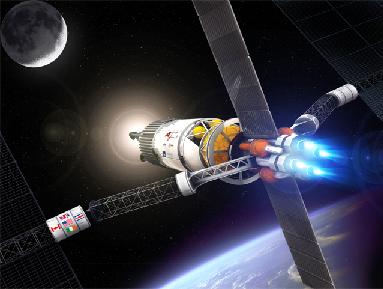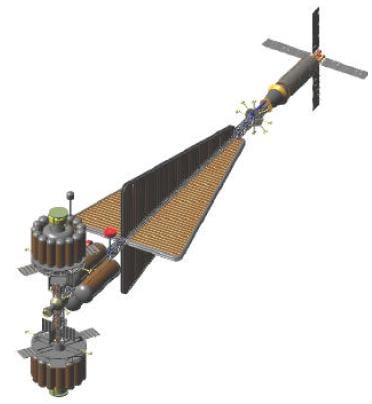This article is more than 1 year old
Plasma space-drive aces efficiency numbers: Set for ISS in 2014
Electro-rocket to open up Mars, the Belt, Jovian moons
Electric plasma tortoise beats chemical rocket hare

Solar plasma-craft: Good for the Earth-Moon vicinity or sunwards
Where a VASIMR comes into its own is in space, in Earth orbit or beyond, where it can keep on exerting its relatively tiny push for days or weeks where a chemical rocket with more poke can make only brief burns due to massive fuel consumption. VASIMR, given time to work, can gradually boost a spacecraft up to velocities that chemically-propelled ships could never dream of - and still have reaction mass left with which to slow down again, all the while carrying plenty of cargo.
In the Earth-Moon neighbourhood, according to VASIMR inventor Franklin Chang Díaz, plasma-propelled craft could be usefully powered by solar panels. The International Space Station, and perhaps in time more ordinary satellites, could maintain or shift their orbits far more economically than they do at present. NASA plans to try out a flight-rated VASIMR unit for manoeuvring the ISS in 2014. This should mean far less space on supply capsules taken up by chemical propellant, permitting more experiments or other payload to be delivered to the station.

A nuclear-powered plasma ship able to reach Callisto, ice moon of Jupiter
Chang Díaz, a plasma physicist and former NASA astronaut with seven Shuttle missions to his credit, believes that solar-powered VASIMR craft would be a massive shot in the arm for space operations in the vicinity of Earth and the Moon. Further out from the Sun, however - towards Mars, the main Asteroid Belt and the outer planets - some other source of power would be needed as solar panels struggle to produce much juice out there. (It will not have escaped the notice of solar-powered Mars rover fans that despite the machines' tremendous longevity they have still not travelled as far as the much shorter-lived Soviet Moon rovers of the 1970s did.)
The only other long-term option for electrical power generation in space is nuclear, which tends to cause a lot of technofear alarmism when deployed (except when this is secret, as it has often been in the case of classified spy satellites).
But if concerns over nukes in space could be eased, nuclear-powered VASIMR could potentially open up the solar system to humanity. Chang Díaz's proposed 39-days-to-Mars astronaut ship would use already existing dustbin-sized reactors of the sort already used to propel submarines: more ambitious plasma-drive ships would make manned journeys to the Belt or even the gas-giant moons of the outer system practical.
Now that the VX-200 prototype has been shown to work, Ad Astra will proceed with developing the VF-200 flight version for the space station. ®
